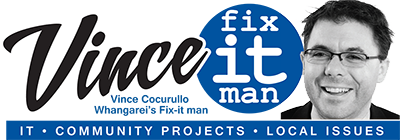Phone Vince on: 021 438 952
May 15 - Information Centres Are An Investment - are we getting enough return?
Information Centres Are An Investment - are we getting enough return?
By Vince Cocurullo
Whangarei District Councillor – Okara Ward
How important are the information centres to you? Do you visit them when you go into a new area? Or has technology changed the way you now book online?
With the growth of Trivago, Expedia, and other mobile apps, the traditional way we book accommodation, or at least ask for information about an area has changed, and for our information centres which typically do this work in our district, now are filled with retail shopping and cafés. Is this the best way to go?
Councils all over NZ and the world are battling with how to deal with technology and getting the right or correct information about a district out to the visitors who come into our district, so they are all questioning the use of the traditional information centre.
Whangarei actually has two official information centres. One is based on State Highway One at Tarewa Park, and one is based at the Town Basin / the Hub. They both have two very distinct different applications and customers. Tarewa Park deals with new people coming into the district, and it has the ability to capture those heading north, who need a break from driving. The Hub deals with people already in the city or those who want to catch a bus. Tarewa Park has approx. 100,000 people going through their doors not including those just going to the Café, whereas the Hub has approx. 130,000 going through their doors and those figures include those going into the museum as well.
Both Whangarei information sites have operating costs of approx. $300,000 each, and both generate income of approx. $135k for Tarewa and $89k for the Hub. So when you break it down, both cost the Whangarei District money to run. However, is an information centre more than just numbers and balancing the books?
As stated above the Tarewa i-SITE, is ideally positioned to welcome visitors to the district. This also allows people to park, rest up and get a chance to find out more about the district. Several Councils within NZ actually have their information centres right in the middle of cities, which causes visitors to actively choose to go into the city, find a park then visit the i-site. When you are travelling, this is a real hassle.
My councillors and I are always forced to rationalise the different aspects of the Council, such as i-sites, spending, and building locations. So the questions to you is, Do you feel our information centres are doing the right job? Do feel that they are in the right locations? Do you feel that your Council is spending enough on getting visitors to your district?
A 2017 review by business consultants MartinJenkins looked at economic development arrangements in Northland and how the i-SITEs contribute, so let’s consider the following stats:
- WDC’s i-SITE indicator found visitor spend on bookings through the visitor centres exceeded their target in 2015/16, and there was a 19 percent increase in visitor spend on bookings during the year (and visitor spend on bookings increased by 9 percent per annum over both 2013/14 and 2014/15).
- In the month of March 2017, the Whangārei Visitor Information Centre recorded a 54 percent increase in retail spend compared to same month in 2016, while The Hub recorded a 35 percent increase in retail spend. However drops in bookings were recorded some months, linked to weather and what events were on.
- In 2014/15 Northland i-SITEs generated a total of $2.83 million in commissioned-based sales. It was estimated that 1.9 percent of visitor expenditure in Northland flowed through the i-SITEs.
- A 2015 study (McIlrath and Gordon, 2015) estimated that in Northland, the i-SITEs generated an additional $9.2 million spend in the region, across accommodation, attractions, events and transport.
- The 2015 study estimated that Northland i-SITEs generated $8.1 million in GDP and 118 jobs within the region. The GDP impact equated to $8.3 per $1 of local government spending on the i-SITEs.
- From 2010–15, Northland’s economy increased 20.0 percent (thanks to farming and real estate – not tourism). Stats from just two months ago show tourism contributes 8.9 per cent of Northland's GDP and employs 8800 Northlanders. The sixth largest regional destination, Northland recorded almost two million guest nights and a visitor spend of $1.1billion in the year ended December 2017.
Is all of the above the most we can achieve? Would better infrastructure, and perhaps new locations for i-SITEs change anything? I would love to hear your thoughts.
Find me online @WhangareiFirst
https://www.facebook.com/WhangareiFirst/
http://www.wdc.govt.nz/YourCouncil/ElectedCouncil/Councillors/Pages/Vince-Cocurullo.aspx



